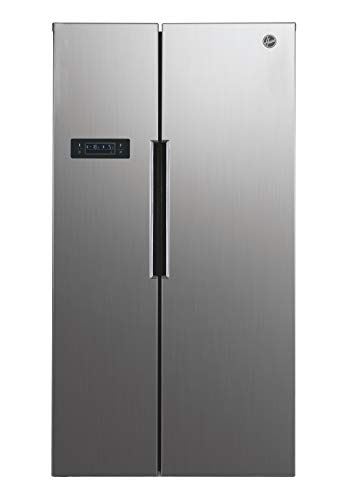Why Choose a Fridge Freezer Frost Free?
If you opt for a fridge freezer frost free it will remove the need to defrost it - making it easier and quicker. They also have more storage space than those that do not have this feature.
Protect areas around the kitchen from water drips when defrosting by putting towels or old sheets close to the appliance.
No need to defrost
Fridge Freezers that use Total No Frost technology circulate cool air continuously throughout each compartment. This prevents the formation of ice on the freezer's walls. This is a great solution for people who like to store lots of items in the freezer, but dislike the idea of having to defrost it each year. If you encounter a build-up of ice, the appliance will typically undergo an automatic defrost cycle.
A frost-free freezer has the obvious benefit of not having to defrost, which is a lengthy and lengthy process that can take up to 24 hours. But, having a frost-free freezer should also mean that you can store more food items in the freezer because it won't lose storage space to ice.
A frost-free freezer is also more energy efficient than refrigerators that employ a traditional defrost technique, saving you money on your electric bills. Defrosting a refrigerator freezer is generally required when it is surrounded by an excessive amount ice. The ice is preventing the refrigeration system from cooling the freezer efficiently.
This is generally caused by an unreliable thermostat that is not regulating the temperature properly. It could also be that the freezer has been closed and opened frequently which will introduce humidity into the freezer. To avoid this ensure that food is cold to put it in the freezer or fridge. Also, ensure that all containers are tightly closed.
By ensuring that your fridge is not overfilled it will decrease the likelihood of defrosting it. It is recommended to store food in separate containers and use smaller amounts at a time rather than overfilling the freezer. This will ensure that the freezer's fan can move air around and is not blocked.
Make sure the door seal is not damaged. This is what keeps room air from getting into the fridge and freezer. If the seal is damaged warm air can get into the fridge and cause the formation of frost on the evaporator. You can stop this from happening by cleaning the evaporator using a specific spray that will aid in removing any frost.
No more the accumulation of ice
The absence of ice accumulation implies that you'll need to defrost your freezer less frequently. If you notice frost on the back of your freezer it could be a sign your fridge-freezer is not functioning properly when it comes to defrosting. If a refrigerator or freezer defrosts properly it will stop its cooling system for about 20 minutes every 6 hours, to ensure that the heaters behind the back wall are able to stop frost from building up on the evaporator coils as well as the back wall of the freezer. This allows air to flow freely between the refrigerator and freezer to prevent food from freezing into a hard consistency.
If your ice buildup is the result of hot air entering your freezer, you can minimize this by ensuring that the door seal isn't broken or blocked. You should also make sure you're not over-loading your freezer or storing things in plastic bags or other containers which stop cold air from circulating around them. Make sure your freezer isn't too close to a radiator or heater.
If you are required to remove an accumulation of ice from your freezer, you should avoid using a knife or any other sharp object because it could damage the appliance. Unplug the appliance and let the ice melt. Then, clean the interior and plug it back into the freezer.
You can also place an old towel in front of the fridge and then wait for it to melt. You can then wipe the freezer clean with a dry, clean cloth and ensure that the temperature is correct before replenishing it.
If you are looking for a new fridge freezer consider one with frost-free functionality. It will save you time and effort. If you'd like more guidance or assistance in choosing your new freezer, contact an Abt expert. They'll help you choose the right appliance that fits your budget and lifestyle. They can also help you with installation and any issues that might arise after the sale.
No more odors
Unlike traditional fridge freezers where bad smells can make their way into the freezer compartment and cause a mess to the food, frost free models do not have any issues with this. They are cooled by air that circulates through the compressor. This air is chilled to a temperature of 0°C so that it doesn't create smells. It's still important to keep food items in airtight containers or wrap them in plastic bags, plastic-coated frozen paper, heavy-duty aluminum foil or similar to decrease the amount of moisture inside the fridge.
These fridge freezers , despite their name "frost-free" still require defrosting. They're not as efficient as conventional freezers. The evaporator coils of the freezer are located at the back and a defrost heating element is used to melt the frost that is formed on them. If this isn't working, frost could build up on the evaporator and lead to problems with cooling.
If you don't have an auto defrost system, you will need to manually defrost the freezer every now and then. The good news is that this only takes a couple of minutes and won't alter the flavor of your food. If you have a Frost Free model, with Total No Frost Technology, it won't require defrost since it circulates cool air constantly around both compartments, preventing any accumulation of ice on the cabinet's walls.
The odors in the refrigerator freezer are created by volatile chemical compounds, some of which react with water, while others don't. If the smells are caused by spoilage of microbial matter, then the chemicals will migrate and contaminate food in the freezer. If the odours are natural, they will stay in the refrigerator until they are released through the vent or are eliminated through the defrost cycle.
If smells begin to permeate the freezer, it's likely there's a problem with the seal or with the cooling process. Moisture can enter the fridge freezer if the freezer door is left open, allowing warm, moist air to enter, or if the food containers are packed too tightly, limiting airflow.
Easy to clean

Freezers in the fridge that do not require manual defrosting are simpler to clean. Clean the freezer with a baking-soda and water solution once it's empty. Simply mix one tablespoon of baking soda with a quarter of warm water, then dip a microfiber cloth into it, and then wipe it down on all surfaces inside. If the seal around the door gets dirty you can clean it. The cooling coils at the back of the fridge are also simpler to clean as they do not have the ice. Also, you should not block the vents on the freezer, because they're in place to allow air to circulate. Paper, crumbs and even twist ties can be sucked into this area, and cause the fan to stop.
It is possible to place activated charcoal in a container in your freezer to decrease or eliminate the smell. This kind of charcoal in the cleaning section of grocery stores.
Before you put your frozen food back into the freezer, it's an ideal idea to line the floor of the freezer using old towels or cloths to ensure that the melted ice doesn't soak up too much water. Make sure to wash your freezer's drawers, bins, and the ice tray prior to putting them back in the freezer.
To prevent the need to defrost to avoid the need to defrost, purchase a refrigerator/freezer that has Total No Frost Technology. This technology keeps the freezer at a constant 0 degrees Fahrenheit and circulates constantly cool air, which stops ice from building up on the walls of the cabinet. It's an option that will save you lots of time and money in the long term, plus it will keep your food fresher longer.
It is recommended to defrost a conventional freezer at least once a year or when the ice layer has reached 1/4 inch in thickness. Always ensure that the gasket on the door is sealing properly. Close the freezer on a piece of white paper. If it comes off easily, the gasket needs to be replaced.
